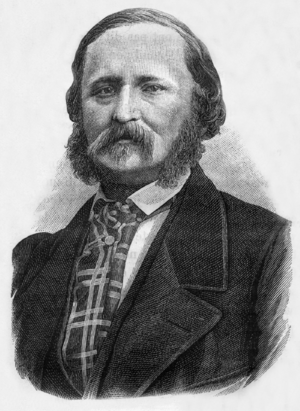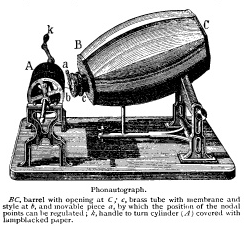Édouard-Léon Scott de Martinville facts for kids
Édouard-Léon Scott de Martinville (born April 25, 1817 – died April 26, 1879) was a French inventor, printer, and bookseller.
He invented the phonautograph, which was the first device known to record sound. He received a patent for it in France on March 25, 1857.
Contents
Early Life and Big Ideas
Édouard-Léon Scott de Martinville was born in Paris, France. His family had Scottish roots. He worked as a printer, which meant he read a lot about new scientific discoveries. This made him very interested in inventing things himself.
He really wanted to find a way to record human speech. He imagined something like how photography captured images, but for sound! He hoped to create a "sound shorthand" that could record every word of a conversation. He even wrote books about shorthand.
The Phonautograph: Recording Sound Visually
Around 1853, Scott de Martinville became very interested in recording sounds using a machine. While he was checking pictures for a physics textbook, he saw drawings of how the human ear works. He wanted to copy this in a machine.
His idea was to use a thin, flexible sheet (like an eardrum) and tiny levers (like the bones in your ear). These levers would move a pen-like tool. This tool would then draw lines on a surface covered in lampblack (a type of soot).
On March 25, 1857, he received a French patent for his invention, which he called the phonautograph.
To record sound, the phonautograph used a horn. This horn was connected to a special sheet that vibrated when sound hit it. A stiff bristle (like a tiny brush hair) was attached to this sheet. As the sheet vibrated, the bristle drew wavy lines onto a cylinder covered in lampblack. Someone had to turn this cylinder by hand.
Scott de Martinville built several of these machines with help from an instrument maker named Rudolph Koenig. Unlike Thomas Edison's later invention, the phonograph, the phonautograph could only create a visual image of the sound. It could not play the sound back. Scott de Martinville wanted people to "read" these sound waves like text, but this turned out to be too difficult.
Even though it couldn't play sound, the phonautograph was useful for scientists. They used it to study sounds, especially vowel sounds. Scott de Martinville sold some phonautographs to science labs. However, he didn't become rich from his invention. He spent the rest of his life as a bookseller in Paris.
The Oldest Song Recording
In 2008, a very old phonautogram (a recording made by a phonautograph) was played back. It was made on April 9, 1860. Scientists at the Lawrence Berkeley National Laboratory in California used special technology called IRENE to turn the "squiggles on paper" into a digital sound file.
This recording was of the French folk song Au clair de la lune. At first, it sounded like a woman or child singing quickly. But later, researchers realized they had played it at the wrong speed. It was actually a 20-second recording of a man, probably Scott de Martinville himself, singing the song very slowly.
This recording is now known as the earliest recording of singing ever found! It was made 28 years before Thomas Edison's famous wax cylinder recordings from 1888.
Other Important Recordings
Scientists also found another phonautogram made by Scott de Martinville. This one has the first lines of an Italian play called Aminta. This recording, made around 1860, is the earliest known recording of understandable human speech.
Some recordings of Scott's voice from 1857 have also been found. At first, they were just unclear snippets. But one of these, a cornet scale recording from 1857, has since been restored. Even earlier experimental records from 1853 have also been found and saved.
Because of their importance, Scott's phonautograms were added to the National Recording Registry by the Library of Congress in 2010. This registry chooses recordings that are "culturally, historically, or aesthetically significant."
The Abraham Lincoln Recording Story
There's a story that in 1863, Scott's phonautograph was used to record Abraham Lincoln's voice at the White House. Some people claimed that a recording of Lincoln's voice was kept by Thomas Edison.
However, experts say these stories are just a myth. They likely started from confused accounts in an old book. There is no real proof that such a recording ever existed. Scott de Martinville did not visit the United States in the 1860s, so he could not have recorded Lincoln himself.
Images for kids
See also
 In Spanish: Édouard-Léon Scott de Martinville para niños
In Spanish: Édouard-Léon Scott de Martinville para niños




